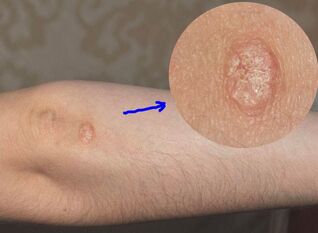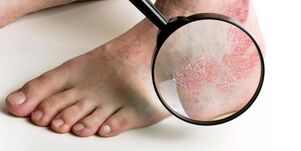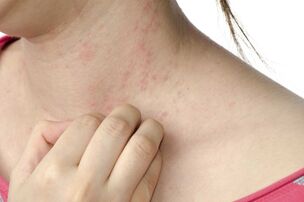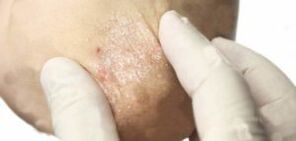Psoriasis is an inflammatory skin disease. Occurs when the immune system is malfunctioning. The development of the disease is divided into clear stages - onset, progression, stabilization and regression. Different stages of psoriasis vary in the appearance of spots and rashes, sore itching, and extensive skin inflammation.
Why is it necessary to distinguish between stages of disease development and what are the features of the course of psoriasis at the beginning of development and in the process of recovery?
Why you need to know the stages of psoriasis

The division of psoriasis into stages is used by doctors for the correct choice of therapeutic methods. The complex of drugs and external agents prescribed to treat inflammation depends on the stage of disease development. At the beginning of the manifestation of the disease, general therapy is needed - vitamin complexes, diet, external aseptic treatment of rash, for example, a course of UV procedures. Also prescribed drugs that stimulate the cleansing of the intestines, blood vessels, liver. Be sure to make a correction of the psycho-emotional state - from a neuropathologist or psychologist.
Psoriasis: treatment in the acute phase and remissionIn the initial stage of the disease, they do not use powerful drugs that suppress the immune system, do not prescribe hormonal oils. These drugs have a long list of side effects, so they are only prescribed when it is impossible to do without them.
In the case of an acute progressive course of the disease, several drugs with different actions are prescribed. Immunosuppressants and glucocorticosteroids are often used to relieve inflammation and reduce itching. External treatments are supplemented with photochemical therapy, ultrasound and laser. Also, agents are prescribed for antiseptic treatment of damaged skin.
In a stabilized state, they continue to take hormonal anti-inflammatory drugs, gradually reducing their dose. To restore damaged skin, oils with a regenerating effect are prescribed.
In forgiveness - support the body. Proper nutrition, take complexes of vitamins and minerals to restore immunity.
Treatment time
The earlier treatment is started, the easier it is to put psoriasis under control. Timely therapy limits the spread of skin inflammation, reduces its extent, and prevents subsequent skin relapses. Since psoriasis is often mistaken as an allergic rash at an early stage, it is necessary to know its initial signs so as not to lose the appearance of a skin disease.
Note: Doctors are still investigating the causes of psoriasis. But it is definitely known that psoriatic skin inflammation is not contagious. It cannot be contracted from a sick person, or an infection in case of injury. This is our personal failure, in the human body.
The cause of psoriasis is an immune failure, which can be caused by various factors. Severe stress, poisoning (including potent drugs, industrial emissions, alcohol), previous infection.
Psoriasis is difficult to treat. The disease is prone to recurrence, relapse. And the therapy itself is symptomatic. It consists of preventing the appearance of new spots and relieving existing itching of the skin.

Which stage of psoriasis is called initial? How to distinguish early psoriasis from diathesis rash? And how will the disease develop in the future?
Psoriasis: initial stage
The first appearance of psoriasis on the skin looks like acne. Most often, the rash appears at the bends of the elbows and knees, or in places where clothes are pressed hard against the body (for example, under the belt at the waist). Rash can also appear along the edge of the hair and under the hair, around the nails and on the nail plates. Sometimes psoriasis occurs on the feet and palms.
Psoriasis almost always appears symmetrically - on the elbows of both hands, or on both sides of the lower back, or on both knees. The acne itself (in medical terminology - papules) in the initial stage has a modest appearance. They have:
- Pink or red;
- Sharp and fuzzy edge;
- Small size - acne at the base does not exceed 2 mm;
- Flat shape - small acne spots at the beginning of the disease have almost no swelling, so they look like spots.
As the disease progresses, flaky skin flakes appear on the acne. They are gray or silver, against the background of a red pimple they look white.
The appearance of scales is accompanied by severe itching. If you do not resist and do not scratch, then the scales are removed, exposing the shiny areas of new pink skin down. It is very thin, palpable, with prolonged scratching of the itchy papules - it is damaged, bleeding.
The initial stage of psoriasis lasts up to 4 weeks.
Psoriasis: the stage of progression
In the progressive stage, the individual acne joins in a common place, forming the so-called psoriatic plaques. They are raised above the surface of the skin and are almost completely covered with skin. At the edges of the psoriatic plaques is a non-flammable reddish-pink edge.
The presence of a lip is a sign of a progressive stage of the disease. The width of the edge is 1-2 mm. The skin on it is inflamed and resembles parchment paper in structure.
The edge represents the point expansion area. This is skin that is already inflamed but still does not peel skin. After a while, it will also be covered with scales. And the patch will expand to cover new areas of skin and form a new wider lip.
With the active development of the disease, adjacent spots merge with each other. At some point, a large, inflamed red spot may form on the human body.
Psoriatic tablets are very itchy, giving a person uncomfortable sensations, disrupting work, rest and sleep. They grow, occupy a large area and form a new rash on clean and healthy skin.
The main sign of the progressive phase is the appearance of new rashes. As soon as the new pimples and blemishes stop appearing, the next stage of psoriasis begins - immobile. This is not yet a complete victory, but it is already a turning point towards recovery.

In the stage of progression, psoriasis is almost always associated with weakness, fatigue, weakness. Depression is common. Possible temperature.
The duration of the progressive stage of psoriasis can be long, several months.
Psoriasis: immobile phase
The main sign of the stationary phase is the cessation of the appearance of new spots and rashes. At the same time, itching also weakens, becomes more tolerable. The rash loses its bright color, whitens, becomes invisible. This is also one of the signs that the process is stabilizing.
The pink rhymes around the plaques disappear as the inflammation stops spreading. Active exfoliation and healing begins, the regeneration of new healthy skin.
It is obvious to the naked eye that the bark grows in the stationary stage. Stairs completely cover the entire surface of the psoriatic spot, leaving no room for rims. Psoriasis takes on the characteristic sleek appearance that is commonly recognized by the general public.
Wide skin in the stationary phase is not dangerous. When all the dead cells come down from the surface of the psoriatic spot, healthy skin with a light shade will remain in place.
Other signs of progression or stabilization
In addition to the appearance of redness, spots, and scaling, there are a number of other signs that can be used to judge the development of the disease. This is the nature of the itching sensations (strong or tolerable), the general state, the depressed mood. And also the presence of temperature.
In the initial stage, the itching is changeable and the redness is incomprehensible. Further, the itching intensifies every day. In the acute stage of psoriasis, it becomes intolerable. Disrupts sleep, rest, interferes with work. The person becomes irritable because the itching sensations do not give him the opportunity to rest.
In the stationary phase, the itching decreases. Every day - a person feels better. The general state of changes in the psyche, negativity and depressive states weaken. The duration of the stationary phase is several weeks - from 2 to 5.
Psoriasis in the mitigation phase
The fading stage of psoriasis is the almost complete disappearance of plaques, spots, redness, inflammation, itching. At this stage of the disease, psoriasis only reminds you of different skin pigmentation. Instead of the former psoriatic spots, it looks easier. The surface of healthy skin has a dark shade.

In some cases, so-called hyperpigmentation is formed. The skin at the site of the psoriasis spots does not become lighter but darker. In any case, the changes in skin pigmentation will be noticeable even for one to two months.
Psoriasis after recovery: the possibility of recovery
The possibility of recurrence of psoriasis is determined by the person's lifestyle, diet, allergic condition and the condition of the body as a whole. It is also determined by the amount of toxins in his body, blood, liver. You can reduce the chances of recurrent skin inflammation if you strengthen the immune system and cleanse the body of toxins in the liver, blood vessels and intestines.
Seasonal relapses of psoriasis are often rare after cleansing. A person remains susceptible to the disease, but the likelihood of its occurrence is significantly reduced.Cleansing the body of toxins and taking vitamin and mineral complexes help boost immunity. This is especially important if immunosuppressants are used during treatment, in the progressive stage of psoriasis. Their need was due to the work of inflammatory mediators. After suppressing the autoimmune defense, it is necessary to restore the immune system.
Clinical manifestations
Psoriasis is characterized by monomorphic outbreaks in the form of papules (nodules) of various sizes, when joined, plaques form and they can spread all over the skin.
At the onset of the disease, in most cases, the rash is limited and is represented by single plaques at the sites of its preferred location (scalp, elongated surface of the elbow, knee joints, sacrum, etc. ).
The plaques are clearly defined by healthy skin, bright pink or deep red, covered with white silvery white, when scratched, you can get a trio of characteristic psoriasis phenomena - "stearin site", "terminal film ", " blood dew ". . .
There are 3 clinical stages of psoriasis: progressive, stationary and regressive.
Classification
Depending on the extent of the inflammatory process, the predominant localization of the rash, the severity of the patient's condition, and other clinical signs, there are exudative, arthropathic, pustular, psoriatic erythroderma, psoriasis folds, and palmar psoriasis. It should be noted that different clinical variants may coexist in one patient.Exudative psoriasis is characterized by a pronounced inflammatory reaction of the skin, which is manifested by the presence of a laminated crust on the surface of the plates, sometimes with many layers, resembling a cake-like appearance (in such cases, this form of psoriasiscalled rupioid). When the crust is removed, a weeping surface is exposed.
Arthropathic psoriasis in clinical appearance, in addition to the usual plaque eruptions, has joint lesions, often small, distal, less often large.
Arthropathy can occur in the presence of skin lesions or precede them. Psoriatic arthritis is manifested by pain, swelling, limited mobility in the affected joints with varying degrees of intensity, from minor arthralgias of individual joints to generalized lesions and disability of patients. The chance of arthropathic psoriasis is higher in patients with severe skin manifestations (psoriatic erythroderma, pustular psoriasis), but a combination of severe joint damage with relatively limited skin rash is possible.
Pustular psoriasis can be generalized (Tsumbusha) and limited, involving the palms and soles (Barbera). Stressful situations, infections, general irrational or local therapy contribute to the onset of this severe form of psoriasis.
Generalized pustular psoriasis occurs with fever, leukocytosis, increased ESR, and a serious general condition. Suddenly, against the background of bright erythema, small superficial pustules appear, accompanied by a burning sensation, soreness, they can be placed in the area of ordinary plaque and on previously unchanged skin. New foci of pustulation appear paroxysmal, occupying large areas of skin. Joint pustules cause detachment of the epidermis in the form of "purulent lakes", erythroderma may develop.
Restricted pustular psoriasis is more common, the rash is localized mainly on the palms and soles in the form of pustules against the background of erythema and skin infiltration. The course, compared to the generalized one, is milder, with a generally satisfactory but persistent state, with frequent recurrences. A local irritant therapy is a provocative factor.
Psoriatic erythroderma is a severe form of psoriasis that develops with a gradual progression of the psoriatic process and fusion of plaque elements to defeat the entire skin, characterized by acute hyperemia, edema, infiltration of the skin with large lamination andsmall, less commonly pityriasis. Subjective - severe itching is often observed. The disease can start with erythroderma. The general condition worsens (fever, weakness, lymph node reaction, heart failure, impaired liver and kidney function, changes in blood tests, hair loss, etc. ).
Folding psoriasis is more common in children and the elderly, especially in patients with diabetes mellitus. The lesions are located in the armpits, under the mammary glands, in the perineum, inguinal-femoral folds, in the navel and are characterized by sharp borders, saturated red color and light skin.
Psoriasis of the palms and soles can exist isolated or simultaneously with lesions of other areas of the skin; The characteristic psoriatic triad is difficult to evoke.
Three clinical stages of psoriasis
Progress phase. Under the influence of provocative factors (trauma, psycho-emotional stress, infectious diseases, inappropriate methods of treatment, etc. ), a worsening of the disease can develop with the appearance of small abundant nodes prone to peripheral growth and plaque formationof various sizes and shapes, which can be isolated or occupy large areas of skin up to universal skin lesions.
In the progressive stage, a symptom of an isomorphic reaction (Kebner phenomenon) is characteristic, which is characterized by the fact that typical psoriatic outbreaks appear at the site of an injury, even minor.
Stationary phase. In the stationary phase, the appearance of new elements ceases and the tendency for peripheral growth of existing tiles disappears.
Regressive phase. The regressive phase is characterized by a decrease in the color intensity of the plaques, their flattening, a decrease in the skin, infiltration, resorption of the elements with the subsequent formation of foci of hypo- or hyperpigmentation at the site of previous rashes.
Treatment
Treatment of psoriasis aims to suppress the proliferation of epithelial cells and eliminate the inflammatory process and is described taking into account the anamnestic data, form, stage, prevalence of the process, concomitant diseases, age and sex of the patient, contraindications to a methodcertain treatment or medication.
For mild, limited manifestations of psoriasis, topical topical therapy in the form of salicylic oil, naphthalene preparations, tar or emollient oils is sufficient. Severe forms of the disease require complex systemic treatment with the use of detoxification, desensitization, anti-inflammatory drugs of different groups, physiotherapeutic methods of therapy, external drugs, etc.
This section will present the most effective and available methods and tools of psoriasis therapy.
Systemic therapy
There are features of patient management at different stages of the psoriatic process. Advanced stage treatment requires special care. During this period, hemodez is prescribed intravenous drip, 30 percent. sodium thiosulfate solution i / v, 10% calcium gluconate solution, with concomitant hypertension, the introduction of magnesium sulfate solution is advised; emollient creams or 1-2 percent are used externally. salicylic ointment.
Aromatic retinoids. Acitretin (neotigazone) - a representative of the second generation of monoaromatic retinoids used to treat severe forms of psoriasis at a dose of 10 to 20-30 mg per day, depending on the severity of the skin process. The mechanism of action of acitretin is to inhibit the proliferation of epidermal cells, to normalize keratinization processes. The drug is particularly effective in combination with PUVA therapy. When prescribing acitretin, we must not forget its teratogenic effect.
Cytostatics.Methotrexate is used in cases of persistent psoriasis and in the presence of contraindications to other methods of treatment, being a folic acid antagonist, acting mainly on cells that are actively multiplying. Very toxic. There are many methods of application, preferably intramuscular administration once a week under strict laboratory control.
Immunosuppressants. Cyclosporine-A is prescribed in severe, widespread cases, resistant to other therapies of psoriasis. This drug has an immunosuppressive effect, has an inhibitory effect on cell growth processes, inhibits the secretion of activated cytokine lymphocytes and the expression of interleukin-1 receptors in immunocompetent cells. With psoriasis, it is prescribed at the rate of 5 mg per 1 kg of body weight per day.
Non-steroidal anti-inflammatory drugsare prescribed for arthropathic psoriasis as well as for reducing acute inflammation in exudative psoriasis and erythroderma. Daily doses of medication and duration of treatment depend on the intensity of the pain syndrome, the degree of inflammation, and individual tolerance.
The use of systemic corticosteroid drugs in the treatment of psoriasis is considered inappropriate, leading to the development of vague forms of the disease, resistant to various types of therapy. In cases of severe arthropathic psoriasis, intraarticular administration of prolonged corticosteroids is possible, the dose and duration of treatment depending on the size of the affected node and the degree of inflammation.
Physiotherapy treatments. One of the most effective treatment methods is PUVA therapy or photochemotherapy (PCT). PCT is a combined application of long-wave ultraviolet radiation (wavelength from 320 to 420 nm) and the photosensitizing drug furocoumarin. The use of photosensitizers is due to their ability to increase skin sensitivity to ultraviolet rays and stimulate melanin formation. PUVA therapy leads to inhibition of cell proliferation, suppression of pathological keratinization, affects the metabolism of prostaglandins, permeability of cell membranes. The peak of the photosensitizing effect occurs 1-3 hours after taking 8-methoxypsoralen. The dose of the drug is chosen taking into account the weight of the patient. Procedures are issued 3-4 times a week, for a course of 20-25 sessions.
Local PCT is also used using external photosensitizers.
The combined use of PUVA and retinoid therapy is called Re-PUVA therapy. Has the highest clinical effect in cases of severe psoriasis.
Selective Phototherapy (SFT) - ultraviolet radiation in the medium wavelength spectrum (wavelength 280-320 nm) without receiving photosensitizers. SFT is used for less pronounced manifestations of the disease, the presence of contraindications to the appointment of PUVA therapy.
How to recognize psoriasis at an early stage
Treatment of psoriasis is most effective at the earliest stage. That is why it is so important to make a timely diagnosis. Only a dermatologist can tell you if you have psoriasis or any other skin disease. However, you can recognize this disease by some characteristic signs:
- Most often, psoriasis first appears on the folds of the hands and feet, on the hairline or where clothes are in close contact with the body or rubbed - under the belt of trousers, various straps and straps.
- At the onset of the disease, a very itchy rash appears, covered with scales of gray or silver skin that are very easy to remove.
- Scale removal reveals thin, shiny, slightly damp skin.
- If you scratch the plate with something like a spatula, removing the scales, then blood will appear in place in the form of tiny dots. However, it is better not to use the latter method for self-determination of psoriasis - it is very easy to get an infection.
For complete confidence, you should see a doctor, as patients themselves often confuse psoriasis with different types of lichen or allergic dermatitis and use unsuitable medications for treatment.
What to do if you find symptoms of early stage psoriasis?
Psoriasis cannot be cured once and for all, so the main goal of therapy is to achieve lasting and maximally long-term remission. You should know that without proper treatment, psoriasis quickly becomes chronic: exacerbations can occur up to 9 times a year, with a duration of up to 15 days.
What to do if you suspect you have psoriasis? Often people, having discovered signs of this disease in themselves, make a big mistake, using "heavy artillery" - hormonal oils (so-called local glucocorticosteroids, or THCS), without consulting a doctor. Usually, patients explain such a step by the fact that they are suspected of having heard from friends that such funds help quickly. This is a big mistake!
What is the risk of such self-medication? Hormonal ointments for psoriasis have many side effects and contraindications. Highly it is highly undesirable to use them without the strict recommendation of a doctor for the duration of use, frequency, area of application in the body, as well as regardless of the individual characteristics of your body.
Non-hormonal agents such as zinc pyrite should be used to effectively treat early psoriasis. Zinc pyrite, or activated zinc, is a very effective medicine for treating psoriasis, which has a complex effect:
- suppresses excessive proliferation of skin cells and inflammation, reducing plaque and peel formation;
- relieves itching;
- protects damaged skin from bacterial and fungal infections;
- restores the lipid layer and protective functions of the skin.























